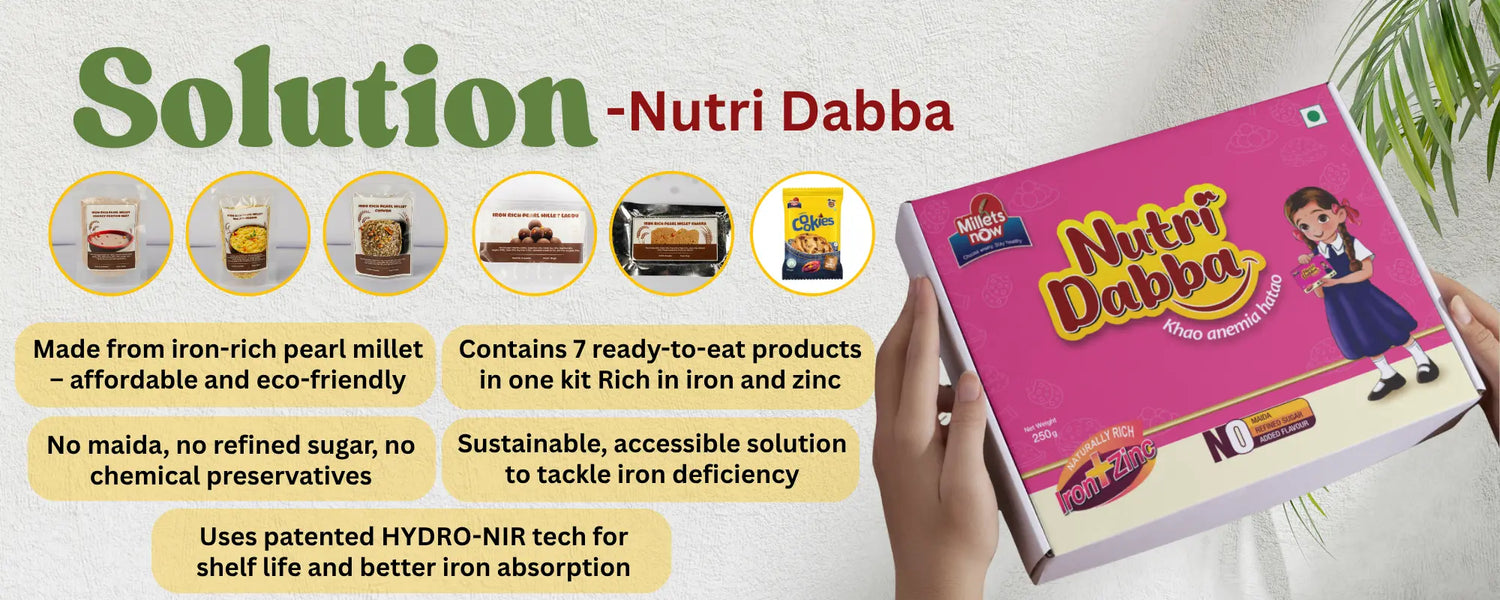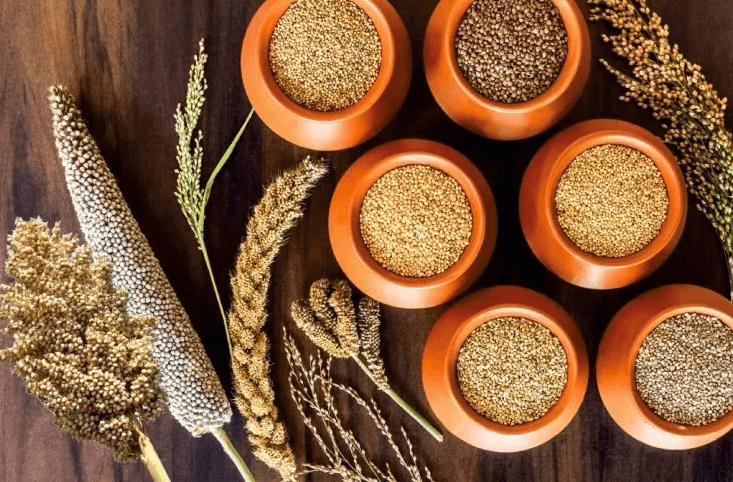

-

Nutri Dabba
Nutri Dabba by Agrozee Organics – Iron-Rich Millet Nutrition in Every Bite...
Why Us..?
By nurturing a community of sustainability advocates and healthy lifestyle enthusiasts, we strive to eradicate hidden hunger by ensuring everyone has access to nutritious, safe, and delicious food. Our commitment goes beyond just feeding; it's about empowering communities with the goodness of millet-based products, paving the way for a healthier, more sustainable future.

Why are we different?
Eco-Friendly Farming Practices:- We are harnessing sustainable methods to protect the environment and promote soil health.
Nature-Driven Nutrition Solutions:- Leveraging the power of nature to provide wholesome, nutrient-rich products.
Enhanced Bio-Availability and Accessibility:- Offering crop supplements that maximize nutrient absorption for optimal health benefits.
Guaranteed Non-GMO Products:- Committed to delivering only non-GMO, pure products for your peace of mind.
Rigorous Triple-Check Quality Assurance:- Ensuring the highest standards through a meticulous three-stage quality check process.
Comprehensive Traceability System:- Providing transparency with an end-to-end traceability model, from farm to table, ensuring trust and integrity in every product.
"This approach not only enhances the original content but also emphasizes the unique values of Agrozee Organics."
Blogs
View all-

Millet Pulao — "The Colourful, Healthy Swap for...
Need a one-pot meal that’s light on the waistline yet big on flavour? Millet Pulao is your new go-to. It cooks just like rice pulao, but trades the polished grains for...
Millet Pulao — "The Colourful, Healthy Swap for...
Need a one-pot meal that’s light on the waistline yet big on flavour? Millet Pulao is your new go-to. It cooks just like rice pulao, but trades the polished grains for...
-

Nachani Satv — Your 5-Minute Calcium & Immunity...
When time is short but health still matters, Nachani Satv (Instant Ragi Health Mix) swoops in like a superhero. Made from finely milled finger millet (ragi) flour, sweetened naturally with...
Nachani Satv — Your 5-Minute Calcium & Immunity...
When time is short but health still matters, Nachani Satv (Instant Ragi Health Mix) swoops in like a superhero. Made from finely milled finger millet (ragi) flour, sweetened naturally with...
-

Masala Millet Pasta – A Healthy Twist to Everyo...
Who said pasta can't be healthy? Say hello to Millets Now's Millet Pasta – a wholesome, flavourful, and guilt-free version of your all-time favourite comfort food. Crafted from nutritious millet flours...
Masala Millet Pasta – A Healthy Twist to Everyo...
Who said pasta can't be healthy? Say hello to Millets Now's Millet Pasta – a wholesome, flavourful, and guilt-free version of your all-time favourite comfort food. Crafted from nutritious millet flours...
Be the First One to Know
Get the latest news on Millets
Now, straight in to your inbox.
FAQs
1. What is millet and types of millets?
Millets are a group of small-seeded, nutrient-rich grains that have been cultivated for thousands of years. Known for their resilience and adaptability, they grow in arid and semi-arid regions and are a staple in many parts of Asia and Africa. Millets are naturally gluten-free and offer numerous health benefits, such as supporting heart health and digestion. The main types of millets are:
Pearl Millet (Bajra): Rich in protein and fiber, helps in managing diabetes and digestion.
Finger Millet (Ragi): High in calcium, good for bone health, and rich in iron.
Foxtail Millet: Contains iron and is good for heart health.
Sorghum (Jowar): Loaded with antioxidants and beneficial for digestive health.
Barnyard Millet: Low in calories, helpful for weight management.
Kodo Millet: High in fiber, suitable for controlling blood sugar levels.
Little Millet: Contains B vitamins and minerals, supports metabolic health.
Proso Millet: Easy to digest and high in protein, supports muscle health.
2. How to store millet?
Millets should be stored in a cool, dry, and dark place to maintain freshness. It is best to keep millets in airtight containers to prevent moisture absorption, which can cause spoilage. For longer shelf life, especially in humid climates, storing millets in the refrigerator or freezer is recommended. This prevents them from becoming rancid and keeps pests away.
3. Which millet is good for which disease?
Millets are versatile grains with specific health benefits associated with each type:
- Diabetes: Foxtail Millet and Kodo Millet have a low glycemic index, helping manage blood sugar levels.
- Heart Health: Foxtail Millet and Sorghum are high in antioxidants and beneficial for cardiovascular health.
- Bone Health: Finger Millet (Ragi) is rich in calcium and supports bone density and strength.
- Digestive Health: Sorghum and Proso Millet are high in fiber, promoting digestion and preventing constipation.
- Anemia: Finger Millet is high in iron, which can help in managing anemia.
- Weight Management: Barnyard Millet is low in calories and can be beneficial for those aiming to manage their weight.
4. How to eat millets: Methods of eating?
To eat millets, there are several versatile methods to include them in your diet:
1. Soaking and Cooking: Rinse millets thoroughly and soak them for 4-6 hours or overnight. Soaking improves digestion and reduces cooking time. After soaking, drain and cook them in water (usually a 2:1 water-to-millet ratio) for a rice-like texture, or add extra water for a porridge consistency.
2. Sprouting: Millets can be sprouted to boost their nutritional value. Soak them overnight, drain, then place in a sprouting jar or cloth for 1-2 days, rinsing twice a day. Sprouted millets can be added to salads or lightly cooked.
3. Using Millet Flour: Millet flour can be used to make rotis, dosas, pancakes, or baked goods. Substitute part of your regular flour with millet flour in recipes for added fiber and nutrients.
4. In Snacks and Side Dishes: Millets can be made into snacks like puffed millet, crackers, or traditional dishes like ladoos and upma.
5. Adding to Soups and Salads: Cooked millets add a nutty flavor and texture to soups and salads, making them more filling and nutritious.
5. Do millets help in weight loss, and if yes, which millet?
Yes, millets are high in fiber and low in calories, making them a great choice for weight management. Barnyard Millet is particularly effective for weight loss as it is very low in calories and helps maintain satiety. Other millets like Kodo Millet and Foxtail Millet are also good choices for weight loss, as their high fiber content aids in digestion and keeps you fuller for longer, reducing overall calorie intake.





